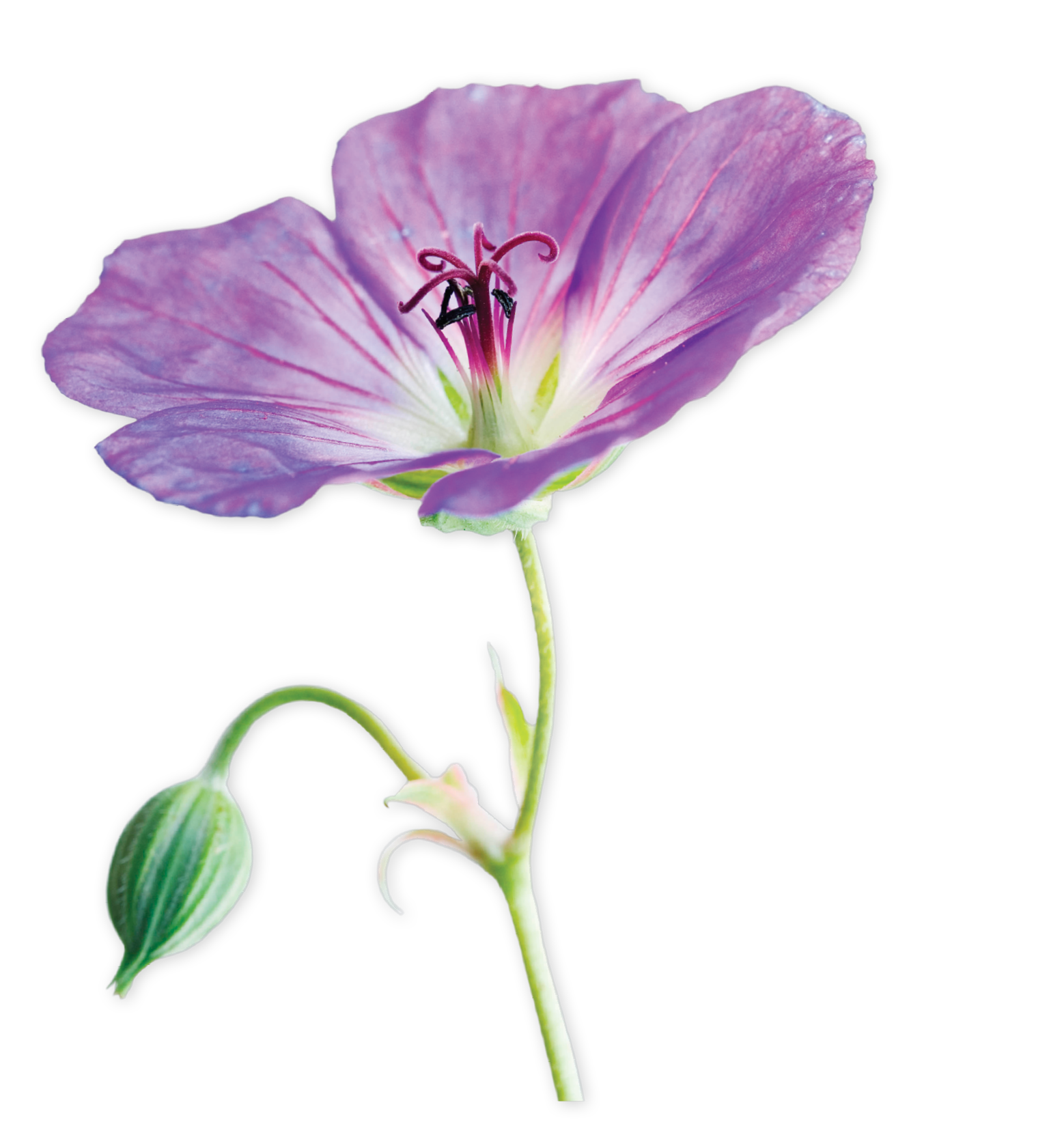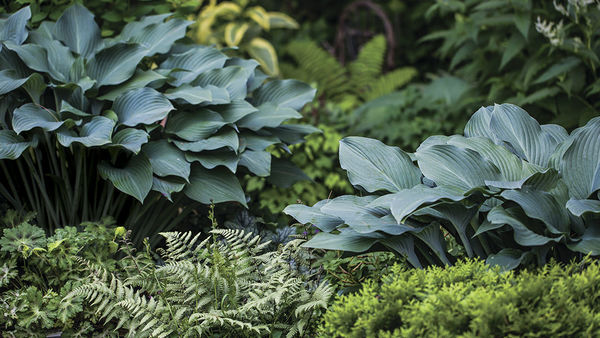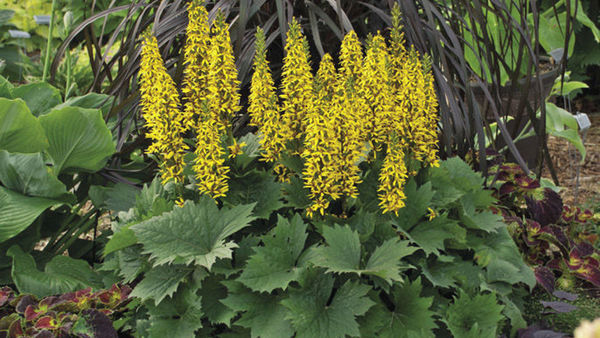
My love of geraniums began when I first saw the luminous flowers of ‘Johnson’s Blue’, certainly one of the most well-known and beloved cultivars of all time. But when I trialed it, I found ‘Johnson’s Blue’ to be a lax plant with a penchant for floppiness and a fairly short bloom period. Although it was the go-to blue geranium for many years, it has been surpassed by an array of newer and more exciting selections.
Until we started our trial, my familiarity with geraniums—aside from the most popular garden staples—was somewhat lacking. But I know gardeners who, astonishingly, have never grown a single geranium. Perhaps that is because there are so many to choose from—maybe too many. I also wonder if gardeners just assume that geraniums are all the same or if the overpopularity of a few select varieties has created a comfort zone that keeps gardeners from straying off the path. After 15 years of testing, I’ve thankfully discovered a vast trove of indispensable geraniums—as well as a few that I wish I’d never laid eyes on.
Top Performers

Rozanne (‘Gerwat’) is unquestionably the most popular geranium today and certainly deserving of the accolades it has received, including the 2008 Perennial Plant of the Year and Royal Horticultural Society’s Award of Garden Merit. The white-eyed, purple-blue flowers are not always present in great quantities, but the plant is perpetually in bloom. I’m especially fond of the iridescent flowers in autumn, when cool weather sets in and not much else is blooming. Rozanne’s large, mounded habit with trailing flower stems is well suited to massing, but a single plant shines on its own, too. Because the flowers are sterile, they do not produce seed and, therefore, bloom for an extended time. In my garden, I grow Rozanne with the lavender-and-creamy-white blossoms of ‘Mrs. Robert Brydon’ clematis (Clematis ‘Mrs. Robert Brydon’, Zones 4–9); this sublime pairing is a hit for several weeks in late summer.

Everything about ‘Orion’ is supersize—from the abundance of the nearly 2-inch-wide, purple-blue flowers to its robustly spreading stems. At 30 inches tall and 6 feet wide, ‘Orion’ is a bit of a bruiser, topping the list as the largest geranium in the trial. Despite its size, ‘Orion’ never seems bulky, thanks to its fine-textured, dissected leaves. Like many geraniums, new leaves emerge as flowering winds down, ultimately pushing the floral stems away from the new growth. This is your cue to shear the old stems back to the base and to let the new leaves have their day.

It’s true that I have quite a few favorites when it comes to geraniums, but if pushed to choose just one for my garden, I would likely pick bigroot geranium (G. macrorrhizum). It’s one of the easiest plants I know of to grow: It is adaptable to sun or shade, is drought tolerant, and doesn’t need shearing. And it’s beautiful, too, with magenta-pink to white flowers in spring; lush foliage that turns red, orange, and burgundy in fall; and a refined spreading habit. Some of its many cultivars have unique flower colors—including ‘Lohfelden’, which has elegant, soft pink blooms, and ‘Czakor’, which boasts lusty, deep magenta blossoms. Bigroot geraniums are easily distinguished from other species by their slightly sticky, aromatic foliage; the scent is variably described as “minty,” “medicinal,” or “malodorous.”

Although it is no longer the most popular geranium in town, I still love ‘Brookside’. In our trial this variety had a compact, well-mannered habit that was far superior to the floppy ‘Johnson’s Blue’. In my own garden—where it gets more competition—‘Brookside’ is a bit rambunctious, but the pretty pale-eyed flowers are still delightful as the stems weave and wind through their neighbors. The flowers are reminiscent of ‘Johnson’s Blue’ but are darker with overlapping petals. Once ‘Brookside’ has finally exhausted itself in midsummer, I cut the stems back hard to encourage new leaves. An added bonus are the finely dissected leaves, which turn red and burgundy in autumn.

Standing out in a field of blue-flowered geraniums requires a little something extra. Golden chartreuse leaves flushed with red are just the thing that set Blue Sunrise (‘Blogold’) apart. The vibrant spring leaf color, which is enhanced in sunlight, fades to yellowish green just as the lavender-blue flowers open in late spring. Blue Sunrise is believed to be a hybrid of yellow-leaved ‘Ann Folkard’ and blue-flowered ‘Buxton’s Variety’ geranium (G. wallichianum ‘Buxton’s Variety’).

‘Sweet Heidy’ is touted for its unique tricolored flowers of lavender-blue, pink, and white. But that’s a somewhat deceptive description because the three colors aren’t present on the flower at the same time. The fresh flowers are pinkish purple with a pale eye, and as they age, the purple morphs into a bluish color.
Quibbling about the flower color does not lessen the remarkable floral display because the blooms are plentiful from late spring into fall. ‘Sweet Heidy’ looks like a pink-flowered Rozanne because of its mounded habit and trailing stems. The rambling stems enable this plant to look great in hanging baskets, in containers, or dangling over low walls.

At first glance, ‘Elizabeth Ann’ (G. maculatum ‘Elizabeth Ann’) is extremely similar to ‘Espresso’ geranium, but in the end, I prefer ‘Elizabeth Ann’ for its superior floral and foliar qualities. Its lavender-pink flowers with nicely overlapping petals are significantly darker than ‘Espresso’. Both cultivars have distinctive, chocolatey bronze–colored leaves in spring, which eventually fade to a summer mix of bronze and green. But the more lustrous leaves of ‘Elizabeth Ann’ bring an unexpected brightness to a shady garden. Both cultivars reseed plentifully and appear to come true from seed, but they express some seedling variability, too; we discovered a number of seedlings, for example, with superior leaf color to either cultivar.

Everything You Need to Know About Geraniums

Don’t get them confused with their cousins
True geraniums (Geranium spp. and cvs.) are often referred to as “hardy geraniums” to distinguish them from their tender cousins: the colorful bedding (or zonal) geraniums (Pelargonium spp. and cvs., top right). An alternate common name of true geraniums, cranesbill, is a nod to their slender fruit, which resemble the beak of a crane.
The foliage can be as cool as the flowers

Most geraniums have attractive foliage, and although quite variable, their leaves are generally lobed and often deeply dissected. Leaf colors range from bright green to gray-green, but there are a number of varieties that have purple, bronze, or yellow leaves. Many, however, don’t hold their foliage color throughout the season. We had the best success with Victor Reiter strain, a seed strain of meadow geranium (G. pratense) that loses its deep purple leaf color in midsummer but turns purple again in fall.
Geraniums can bloom from spring to autumn for a few weeks or many months, depending on the variety. While the blue-flowered selections seem to be de rigueur for modern gardens, geraniums come in pink, magenta, purple, and white. The somber, near-black blossoms of the aptly named mourning widow geranium (G. phaeum) are some of the most interesting.
Trim them back for a better habit
Although geraniums are not high-maintenance plants, most must be cut back after flowering. Shearing stems back to new basal leaves reins in unruly habits and rejuvenates plants to an almost springlike quality. There are a few exceptions to this rule: Bigroot geranium (G. macrorrhizum), Cambridge geranium (G. cantabrigiense), bloody geranium (G. sanguineum), and Wlassov’s geranium (G. wlassovianum) do not need shearing after flowering. You can also skip the shearing on late-blooming creeping geranium (G. soboliferum) and everblooming Rozanne geranium (G. ‘Gerwat’). Deadheading also reduces self-seeding, which can be excessive.
Color doesn’t end when the flowers do

Come autumn, many geraniums turn shades of purple, red, orange, or yellow—and often on the same plant (right). Cambridge geranium and bigroot geranium are among my picks for the best autumnal displays.
They’re not picky about conditions
Geraniums are generally easy to grow in a variety of light conditions from full sun to full shade and in most soils, except those that are overly wet or too dry. Rich, moist soil is ideal for most geraniums—even drought-tolerant species, such as bigroot geranium. Morning sun will encourage stronger habits and better flower production on shade-loving geraniums, and will enhance leaf color on bronze-leaved forms, like ‘Elizabeth Ann’ and ‘Espresso’. In hot regions, afternoon shade is priceless in keeping geraniums happy and healthy.
Pests and diseases plague only some types
Geraniums are rarely troubled by diseases or pests, but powdery mildew, leaf spotting, rabbits, and Japanese beetles are occasional problems. Powdery mildew was notable on cultivars of meadow geraniums only, while Japanese beetles found the many cultivars of Druce’s geranium (G. oxonianum) delectable. And mourning widow geraniums, especially ‘Margaret Wilson’, proved to be irresistibly succulent treats for rabbits.

How We did the Trial 
Number evaluated: 180
Criteria: Ornamental qualities, ease of growth, hardiness, and disease and pest resistance
USDA Hardiness Zone: 5b
Conditions: In our full-sun trial garden (with well-drained, alkaline, clay-loam soil) or in our shade trial garden (with dappled shade from nearby trees and moist, well-drained soil)
Care: Minimal, thereby allowing the plants to thrive or fail under natural conditions
New Kids on the Block
Plant breeders can’t get enough of geraniums. Just when you think you’ve seen every cultivar out there, another crop is introduced. Some of these new selections are fleeting, but others are showing enough promise in their first few years of trialing that I believe they deserve a bit of press.

Because it blooms out of sequence from most other geraniums, ‘Starman’ creeping geranium (G. soboliferum ‘Starman’) was a bit of a sleeper; it wasn’t until the second year that I realized it was something special. It is a prolific late bloomer—not starting until late summer—with a charming two-toned flower. The 1½-inch-wide purple flowers are patterned with darker veins and marked with a prominent starburst in their centers. ‘Starman’ has a refined mounded habit (16 inches tall and 36 inches wide) all summer and doesn’t need deadheading. It tops off the impressive floral show with respectable red fall color, too.

Given my newfound appreciation for ‘Starman’, I was jazzed about evaluating ‘Butterfly Kisses’ creeping geranium (G. soboliferum ‘Butterfly Kisses’). Like ‘Starman’, ‘Butterfly Kisses’ is equally prodigious in bloom but begins flowering a week or so later (at the very end of summer) and carries on well into late fall. The 1½-inch-wide, light purple-pink flowers are without a starry eye; each blossom is, instead, beautifully striated with prominent red-purple veins. ‘Butterfly Kisses’ is slightly bigger (20 inches tall and 50 inches wide) than ‘Starman’ and does show off some red and orange fall color.

I’m usually reticent to talk about plants that have just begun their trial, but I’m quite taken by ‘Perfect Storm’, a new introduction with pretty, dark-eyed, magenta-pink flowers. Dramatic, dark purple veins burst from the smoldering black eye, giving the plant a singular exuberant look. Last year, ‘Perfect Storm’ was in constant bloom from spring to late fall, with handsome, downy, gray-green leaves complementing the eye-catching flowers. The low-growing plant (8 inches tall and 24 inches wide) has trailing stems radiating out from the mounded crown. I imagine that ‘Perfect Storm’ cascading over a stone wall or in a hanging basket would be perfection.
Richard Hawke is the plant evaluation manager at the Chicago Botanic Garden in Glencoe, Illinois.
Photos: Doreen Wynja; Dave Zubraski/www.gapphotos.com; Steve Aitken; Dency Kane; Jerry Pavia; Martin Hughes Jones/www.gapphotos.com; www.millettephotomedia.com
Photos: Richard Bloom/www.gapphotos.com; Nancy J. Ondra; Ron Evans/www.gapphotos.com; FhF Greenmedia/wwwgapphotos.com; courtesy of www.songsparrow.com; courtesy of Luc Klinkhamer
Sources
The following mail–order plant sellers offer many of the geraniums featured:
Digging Dog Nursery, Albion, Calif.; 707-937-1130; www.diggingdog.com
Geraniaceae.com, Kentfield, Calif.; 415-461-4168; www. geraniaceae.com
Lazy S’S Farm Nursery, 2360 Spotswood Trail, Barboursville, VA 22923; www.lazyssfarm.com






















Comments
Log in or create an account to post a comment.
Sign up Log in